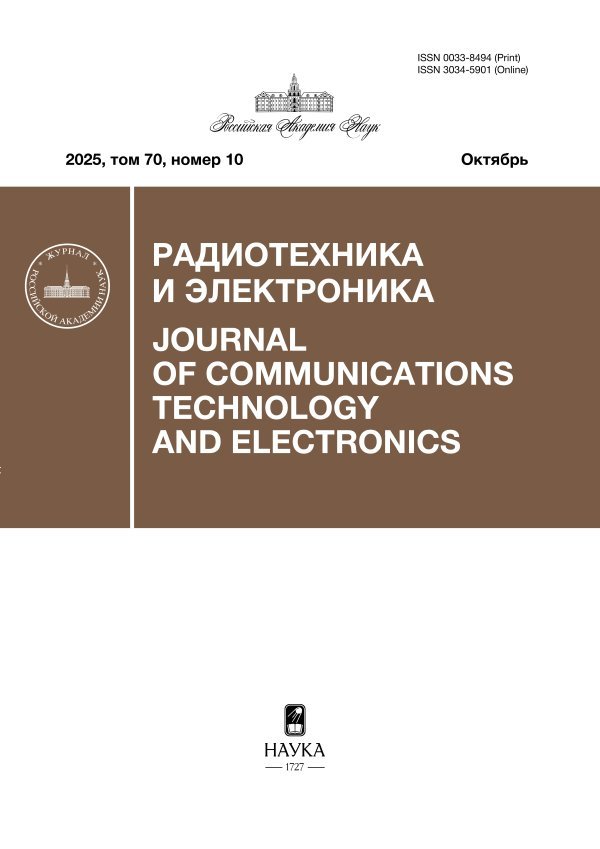Formation of a nutation line contour under conditions of a strong inhomogeneous field in flow-thru nuclear magnetic spectrometers with a rapid change in flow velocity
- Authors: Davydov V.V.1,2, Gol’dberg A.A.1, Davydov R.V.1,2,3
-
Affiliations:
- Peter the Great Saint Petersburg Polytechnic University
- Bonch-Bruevich Saint Petersburg State University of Telecommunications
- Alferov University
- Issue: Vol 69, No 7 (2024)
- Pages: 669-677
- Section: PHYSICAL PROCESSES IN ELECTRONIC DEVICES
- URL: https://gynecology.orscience.ru/0033-8494/article/view/681464
- DOI: https://doi.org/10.31857/S0033849424070099
- EDN: https://elibrary.ru/HYUZFJ
- ID: 681464
Cite item
Abstract
The problems arising in experiments using liquid flows are considered. The advantages of using nuclear magnetic resonance-based devices for flow parameter control both in research and in industrial parameter measurements are noted. A new method for forming a nutation line contour with a given profile from a liquid flow with magnetization inversion has been developed, and the features of controlling the processes of this contour formation have been established. Experimental studies have been conducted and the possibility of applying the new method for measuring the liquid flow rate q with rapid changes in the flow velocity has been proven. New coefficients in the Bloch equations are proposed that describe the motion of three magnetization components (Mx’, My’ and Mz’) in the nutation coil in a liquid flow in a strong inhomogeneous field. The nutation line contour has been calculated for various parameters B0 and q. The minimum value of the magnetic field inhomogeneity has been established taking into account q and the parameters of the current medium, which must be ensured in the nutation coil location sector when forming the line contour at the noise level to implement the “magnetic” mark mode when measuring q. A comparison of theoretical calculations with experimental data was carried out.
Full Text
About the authors
V. V. Davydov
Peter the Great Saint Petersburg Polytechnic University; Bonch-Bruevich Saint Petersburg State University of Telecommunications
Author for correspondence.
Email: Davydov_vadim66@mail.ru
Russian Federation, Polytechnicheskaya Str, 29, St.Petersburg, 195251; Bol’shevikov Ave., 22, St.Petersburg, 193232
A. A. Gol’dberg
Peter the Great Saint Petersburg Polytechnic University
Email: Davydov_vadim66@mail.ru
Russian Federation, Polytechnicheskaya Str, 29, St.Petersburg, 195251
R. V. Davydov
Peter the Great Saint Petersburg Polytechnic University; Bonch-Bruevich Saint Petersburg State University of Telecommunications; Alferov University
Email: Davydov_vadim66@mail.ru
Russian Federation, Polytechnicheskaya Str, 29, St.Petersburg, 195251; Bol’shevikov Ave., 22, St.Petersburg, 193232; Khlopin Str., 8, build.3, St.Petersburg, 194021
References
- Gizatullin B., Gafurov M., Vakhin A. et al. // Energy and Fuels. 2019. V. 33. № 11. P. 10923.
- Marusina M.Y., // . 2018. V. 19. № 10. P. 2771.
- Zargar M., Johns M.L., Aljindan L.M. et al. // SPE Production & Operation, 2021. V. 36. № 2. P. 423.
- Gizatullin B., Gafurov M., Rodionov A. et al. // Energy and Fuels. 2018. V. 32. № 11. P. 11261.
- Marusina M.Y., Bazarov B.A., Galaidin P.A. et al. // Measurement Techniques. 2014. V. 57. № 5. P. 461.
- Davydov V., // . 2022. V. 15. № 2. P. 457.
- Kashaev R.S., // . 2019. V. 86. № 5. P. 890.
- Marusina M.Y., Bazarov B.A., Galaidin P.A. et al. // Measurement Techiques. 2014. V. 57. № 6. P. 580.
- O’Neill K.T., Brancato L., Stanwix P.L. et al. // Chem. Eng. Sci. 2019. V. 202. P. 222.
- Давыдов В.В.//Оптика и спектроскопия. 2016. Т. 121. № 1. С. 20.
- Eremina R., // . 2023. V. 54. № 4-5. P. 435.
- Жерновой А.И., Дьяченко С.В. // ЖТФ. 2015. Т. 85. № 4. С. 118.
- Deng F., Xiao L., Wang M. et. al. // Appl. Magnetic Resonance. 2016. V. 47. № 10. P. 1239.
- Sadovnikova M.A., Murzakhanov F.F., // . 2012. V. 15. № 17. P. 6204.
- Davydov R., // 15. № 5. P. 1748.
- Deng F., Xiong C., Chen S. // Petroleum Exploration and Development. 2020. V. 47. P. 855.
- Давыдов В. В., Мязин Н. С., Давыдов Р.В. // Измерительная техника. 2022. №6. С. 52.
- Давыдов В. В., Мязин Н. С., Давыдов Р.В. // Измерительная техника. 2022. №4. С. 49.
- Давыдов В. В., Величко Е. Н., Дудкин В. И., Карсеев А. Ю. //Метрология. 2014. № 5. С. 32.
- Давыдов В.В., Дудкин В.И., Николаев Д.И. и др. // РЭ. 2021. Т. 66. №10. С. 1017.
- Кашаев Р. С., Козелкова В. О., Овсеенко Г. А. и др. // Измерительная техника. 2023. №5. С. 52.
- Deng F., Xiong C., Chen S. // Petroleum Exploration and Development. 2020. V. 47. P. 855.
- Fouilloux P., et al. // . 2023. V. 253. P. 126307.
- Safiullin K., et al. // . 2022. V. 210. P. 110010.
- Cao G., // . 2023. V. 13. № 1. P. 4558.
- Leshe A. Nuclear Induction. Berlin: Verlag Wissenschaften, 1963.
- Abragam A. The Principles of Nuclear Magnetism. Qxford: Clarendon Press, 1961.
- Jacobsohn B.A., Wangsness R.K. // Phys. Rev. 1948. V. 73. № 9. P. 942.
- Bloch F., Wangsness R.K. // Phys. Rev. 1950. V. 78. № 1. P. 82.
Supplementary files














